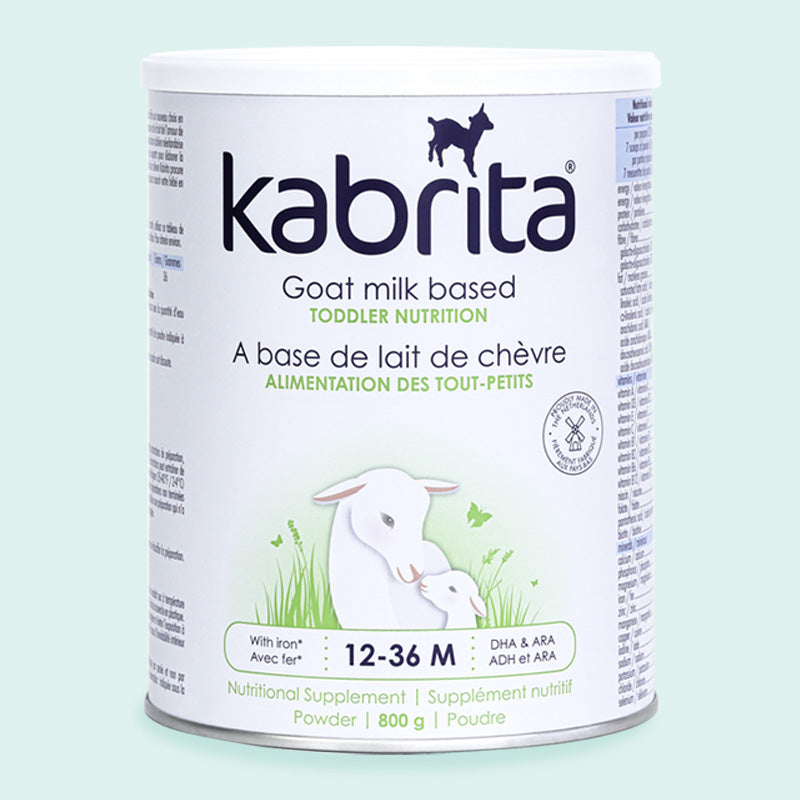Join Kabrita's Medical Herd!
Join thousands of medical professionals to ensure that you’ll be among the first to access:
- New scientific discoveries in the goat milk & childhood nutrition field
- Invites to in-person and virtual events
- Free continued education
- Kabrita product updates & educational resources
Join now to ensure you have the latest insights to share with your patients and peers.
Introducing Kabrita Goat Milk-Based Toddler Nutrition
Our team of nutritionists, researchers, and food scientists have thoughtfully designed Kabrita Goat Milk-Based Toddler Nutrition with evidence-based ingredients to support the healthy growth and development of toddlers 12-36 months of age.
- Proudly crafted in The Netherlands
- Kabrita is naturally easy to digest and mild in taste, making it a great choice for your patients.

Inspired by nature, backed by science
Kabrita Goat Milk-Based Toddler Nutrition is the first goat milk-based toddler nutrition on the Canadian market.
The proteins in our premium goat milk are easier to digest than cow milk proteins.¹⁻⁶ Goat milk naturally contains 5x higher levels of prebiotic oligosaccharides compared to cow milk⁸⁻⁹ which may support a healthier gut microbiome and can help reduce the growth of pathogens.¹⁰

Nutritionally advanced
Kabrita Goat Milk-Based Toddler Nutrition contains 24 nutrients including vitamin D, iron, and DHA to support healthy, growing toddlers 12-36 months of age.

Vitamin D
86% of Canadian toddlers 12-36 months of age consumed less than the recommended amount of Vitamin D (15μg/day) from foods alone.¹¹ Each 200mL serving of Kabrita Goat Milk-Based Toddler Nutrition provides 0.90μg of vitamin D, which is 6% of the daily recommendation.¹²

Iron
It’s estimated that globally 43% of toddlers 12-36 months of age have iron deficiency.¹³ Each 200mL serving of KabritaGoat Milk-Based Toddler Nutrition provides 2.4mg of iron which is 34% of the daily recommendation. Daily RDA/AI of iron for Canadian children aged 1-3 is 7mg.¹⁴

DHA
Please remove the link from the body text as the block is already linked. Or disable the link block setting.
Explore the benefits of goat milk
The foundation of Kabrita Goat Milk-Based Toddler Nutrition is premium goat milk from 100+ family-run farms in the Netherlands.
- Goat milk has been proven to be a safe base for child nutrition.¹⁸
- Goat milk has lower alpha s1-casein levels than cow milk, resulting in softer and looser curds, which are more easily digested.⁴⁻⁵
- Goat milk naturally contains 5x higher levels of prebiotic oligosaccharides compared to cow milk, which may support a healthier gut microbiome and can reduce the growth of pathogens,⁸⁻⁹
Our commitment to future generations
We intend to leave behind a better planet for our children, which is why we are dedicated to sustainable practices. In fact, 100% of our farmers participate in the Dutch Kwaligeit program which prioritizes animal health and welfare, energy consumption, and the environment.
Our operations are powered by 94% renewable energy, our canisters are recyclable, and our newest facility is 100% carbon and nitrogen free.

About Kabrita Medical
Doing good for babies and the world they live in
Kabrita Medical was founded to bring the latest goat milk and infant formula science to healthcare professionals who work first-hand with children and their families. We champion the wellness of every child, and we help caregivers and practitioners to stay informed and empowered to make the best feeding choices for their families.


Our mission
Empower healthcare professionals to make confident and informed feeding recommendations grounded in scientific evidence.
Our vision
To be the most trusted childhood nutrition brand; driven by science and pushing the industry forward.
Our values

Inspired by nature, backed by science
We geek out over the natural benefits of goat milk and apply scientific rigor to everything we do in the field of childhood nutrition.

Challenge the status quo
We embrace a challenge, we actively search for improvements, we are not afraid to do things differently, and we are not afraid to create a world where all feeding journeys (breast, formula, or both) are celebrated without an ounce of judgment.

Support our herd
We take care of our village – compassionately supporting the needs of our families, healthcare professionals, farmers, goats, and employees. We strive to meet their needs by offering support, information, and understanding every step of the way.

Feed curiosity
We empower families and healthcare professionals through knowledge & innovation.

Do good
We give back and champion the collective health of all families. We recognize our responsibility to the planet and future generations. We champion the wellness of every child, the well-being of our goats, and the welfare of the planet we all share.
Powered by Ausnutria
Kabrita is powered by Ausnutria, a research-driven Dutch dairy company with more than 100 years experience in the production of dairy.
Ausnutria Nutrition Institute
Ausnutria is committed to the continuous development of our products by further exploring the field of childhood and dairy nutrition research. The Ausnutria Nutrition Institute is a fantastic resource housing the latest knowledge and scientific insights.

References
1. Maathuis A, Havenaar R, He T, Bellmann S. Protein Digestion and Quality of Goat and Cow Milk Infant Formula and Human Milk Under Simulated Infant Conditions. J Pediatr Gastroenterol Nutr. 2017;65(6):661-666.
2. Almaas H, Cases AL, Devold TG, Holm H, Vegarud GE. In vitro digestion of bovine and caprine milk by human gastric and duodenal enzymes. Int Dairy J. 2006;16(9):961-968.
3. Pintado ME, Xavier Malcata F. Hydrolysis of ovine, caprine and bovine whey proteins by trypsin and pepsin. Bioprocess Biosyst Eng. 2000;23(3):275-282.
4. Young W. Park, Haenlein GFW, eds. Handbook of Milk of Non-Bovine Mammals. 1st ed. Iowa State University Press; 2008.
5. Park YW, Juárez M, Ramos M, Haenlein GFW. Physico-chemical characteristics of goat and sheep milk. Small Rumin Res. 2007;68(1):88-113.
6. Ceballos LS, Morales ER, de la Torre Adarve G, Castro JD, Martínez LP, Sampelayo MRS. Composition of goat and cow milk produced under similar conditions and analyzed by identical methodology. J Food Compost Anal. 2009;22(4):322-329.
7. Health Canada. Canada’s dietary guidelines. Canada Food Guide. Published March 16, 2022. Accessed May 7, 2024. https://food-guide.canada.ca/en/guidelines/
8. van Leeuwen SS, Te Poele EM, Chatziioannou AC, Benjamins E, Haandrikman A, Dijkhuizen L. Goat Milk Oligosaccharides: Their Diversity, Quantity, and Functional Properties in Comparison to Human Milk Oligosaccharides. J Agric Food Chem. 2020;68(47):13469-13485.
9. Martinez-Ferez A, Rudloff S, Guadix A, et al. Goats’ milk as a natural source of lactose-derived oligosaccharides: Isolation by membrane technology. Int Dairy J. 2006;16(2):173-181.
10. Oliveira DL, Costabile A, Wilbey RA, Grandison AS, Duarte LC, Roseiro LB. In vitro evaluation of the fermentation properties and potential prebiotic activity of caprine cheese whey oligosaccharides in batch culture systems. Biofactors. 2012;38(6):440-449.
11. Health Canada. Do Canadian Children Meet their Nutrient Requirements through Food Intake Alone? Published online 2012.
12. Health Canada. Dietary reference intakes tables: Reference values for vitamins. Published July 20, 2005. Accessed March 28, 2024. https://www.canada.ca/en/health-canada/services/food-nutrition/healthy-eating/dietary-reference-intakes/tables/reference-values-vitamins.html
13. Cerami C. Iron Nutriture of the Fetus, Neonate, Infant, and Child. Ann Nutr Metab. 2017;71 Suppl 3(Suppl 3):8-14.
14. Health Canada. Dietary reference intakes tables: Reference values for elements. Published July 20, 2005. Accessed March 28, 2024. https://www.canada.ca/en/health-canada/services/food-nutrition/healthy-eating/dietary-reference-intakes/tables/reference-values-elements.html
15. Lacombe RJS, Kratz RJ, Holub BJ. Directly quantified dietary n-3 fatty acid intakes of Canadian toddlers are lower than current dietary recommendations. Nutr Res. 2018;53:85-91.
16. Health Canada. Dietary reference intakes tables: Reference values for macronutrients. Published July 20, 2005. Accessed March 29, 2024. https://www.canada.ca/en/health-canada/services/food-nutrition/healthy-eating/dietary-reference-intakes/tables/reference-values-macronutrients.html
17. Dietitians of Canada. Eating Guidelines for Omega-3 Fats. Published online 2011. https://www.healthstandnutrition.com/wp-content/uploads/2011/09/Eating-Guidelines-for-Omega-3.pdf
18. EFSA Panel on Dietetic Products, Nutrition and Allergies (NDA). Scientific Opinion on the suitability of goat milk protein as a source of protein in infant formulae and in follow‐on formulae. EFSA J. 2012;10(3):2603.

